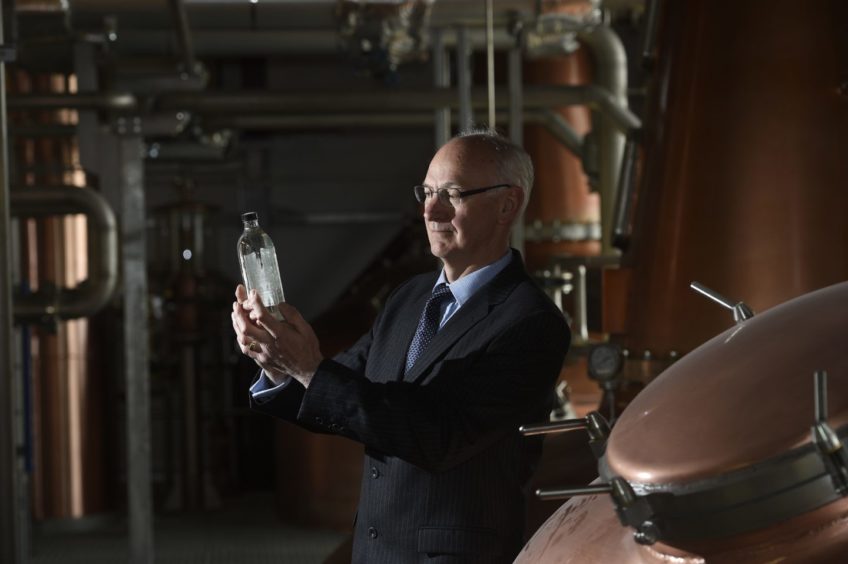A Fife distillery is one of 17 in Britain which have today received the first phase of a £10 million UK Government fund to go green.
Eleven businesses across Scotland and a further six in England will be able to kickstart green innovations thanks to the government backing, helping them harness energy sources such as low-carbon hydrogen, biomass and repurposed waste to power their operations.
The successful distilleries are receiving between £44,000 and £85,000 in the first phase of funding, helping them boost decarbonisation research and development, with schemes including the use of hydrogen and biofuel boilers and geothermal energy in their production processes.
The funding will help prevent pollution equivalent to taking 200,000 cars off the road.
Fife company John Fergus and Co Ltd, which operates the InchDairnie Distillery in Glenrothes, is to receive £71,812 for the use of hydrogen on site to decarbonise processed heat.
Ian Palmer, managing director, revealed that the distillery was founded almost six years ago with a “green” plan firmly in place from the word go.
“We are a new distillery and started distilling in 2015. We are not a traditional distillery in the kind of the old world type of thinking, we are very much a modern distillery with modern thinking,” he said.
“When we designed the distillery we put in a lot of modern technology and part of that went into our energy consumption and how we were using it, so we were consuming as little as possible.
“We designed a very efficient distillery to begin with, but there was a point where we couldn’t go further because the technology didn’t exist at that time so this gives us an opportunity to basically take an energy-efficient distillery and basically do, as the phrase says, decarbonise it.”
Green journey
The funding will allow John Fergus and Co to continue on their journey to decarbonisation with their successes so far on energy displayed in their recent carbon footprint report.
“It is giving is an opportunity to reduce our carbon footprint because we’ve actually published our carbon footprint around November. We published the whole report and it makes absolutely wonderful reading. It is very technical and was done by a third party who calculated our carbon footprint for us,” Mr Palmer added.
“This now allows us to take a look at the carbon we are generating at the distillery and see if we can in fact remove that and our approach is to take a look at the use of hydrogen.
“There are different ways we are looking at that – can we produce the hydrogen on site and we have two potential routes to do that or can we ship in the hydrogen that is actually being produced by a plant here in Fife. We would bring in tanker loads of hydrogen which would have been produced principally using wind power. In effect it would be ‘green’ hydrogen.
“That is one option for us and this feasibility study will take a look at how we can stop using mains gas as our principal heat source and convert that over to hydrogen and effectively reduce our carbon footprint at the distillery.
“So basically what we are doing at the distillery is seeing if we can replace all the gas we are burning in our steam boiler with hydrogen which should have a much much lower carbon footprint.”
Gazing into the future
InchDairnie doesn’t have anything in the market just yet as, being a young enterprise, everything is still maturing.
Mr Palmer added: “The first brand that we will be putting into the market will actually be our grain whisky called RyeLaw which is made predominantly from malted rye. The majority of what we are producing is being sold to various blending houses that have blended whisky brands but don’t have their own distilleries. Our principal brands will be Lauders and Islay Mist.”
But as whisky takes a long time to mature, trying to anticipate how customers will be thinking in more than 10 years’ time is a gamble the distillery must take.
“We have the advantage of having a green field as that is what we built it on. There was no heritage, there was no baggage which makes life in this sort of subject a lot easier. What we are producing today will not be sold for maybe 12 years so what you are looking at is what will the consumer in 12 years be thinking?
“Based on the direction of travel of carbon footprint and ethical consumption, in 12 years’ time the direction of travel would suggest the consumer will be even more sensitive in the future, so we need to be 12 years ahead of the consumer which is not a very easy place to be as you are hoping the consumer will still be thinking that way.
“The current pandemic has seen a shift at the moment in consumer habits, will those habits continue after that and will the direction of travel remain the same? That is the risk we just have to take.”
‘Raise a toast’
Energy minister, Kwasi Kwarteng, said: “Building back greener from the pandemic is something we can all raise a toast to.
“Every business can play a part in the green industrial revolution and this funding will allow UK distilleries to lead the way by making their production cleaner while also creating jobs.”
The Scotch whisky industry supports 40,000 jobs across the UK, with more than 10,000 people directly employed in Scotland – 7,000 of them in rural areas. According to Government figures, in 2019, the UK distilleries industry grew by 20%.
The “Greener Distilleries” initiative is part of a UK government commitment to reaching net zero by 2050.
World famous
Scotland minister Iain Stewart said: “It is fantastic to see so many Scottish distilleries awarded this UK Government funding. Scotland is world famous for its whisky and gin, with the spirits industry one of our greatest success stories.
“This new funding will help the industry continue to build on its great work in tackling climate change.
“From Aberdeen and Glasgow to Orkney and South Uist, this funding will help create jobs, support local businesses and communities and build back greener ahead of COP26 in Glasgow later this year.”
Dagmar Droogsma, director of industry at the Scotch Whisky Association, said: “The Green Distilleries Fund is an important step on the industry’s journey towards net-zero. It will help the industry test new technologies, like hydrogen, which can be rolled out at scale in future years and enable Scotch Whisky to further drive down emissions and protect the natural environment.
“With COP26 taking place in Glasgow this year, the Scotch Whisky industry has ambitious plans to build on the success of the last decade when distilleries cut greenhouse gas emissions by 34%. There is more to do, but with continued support from government the Scotch Whisky industry can continue to work towards a more sustainable future.”













